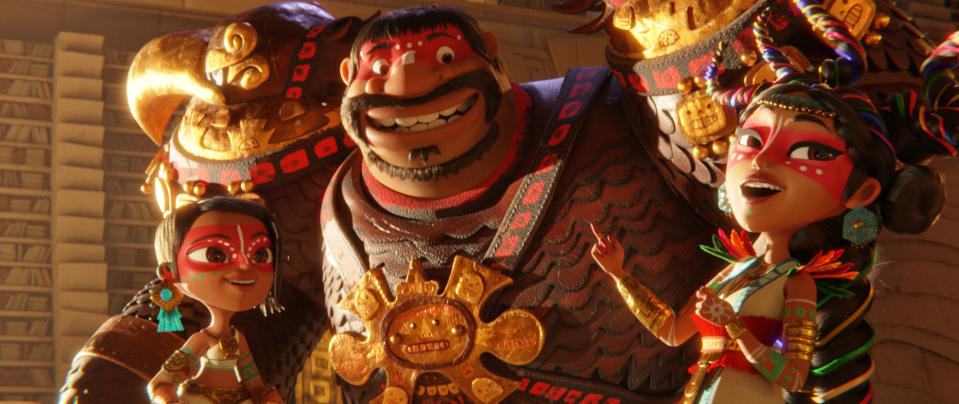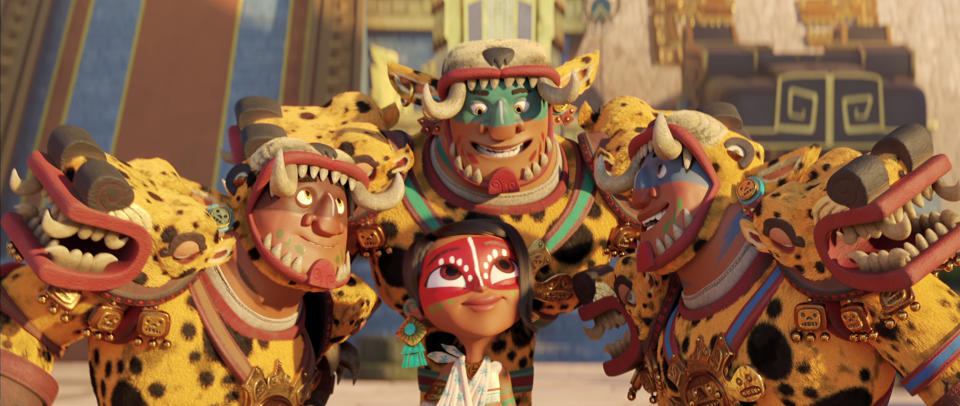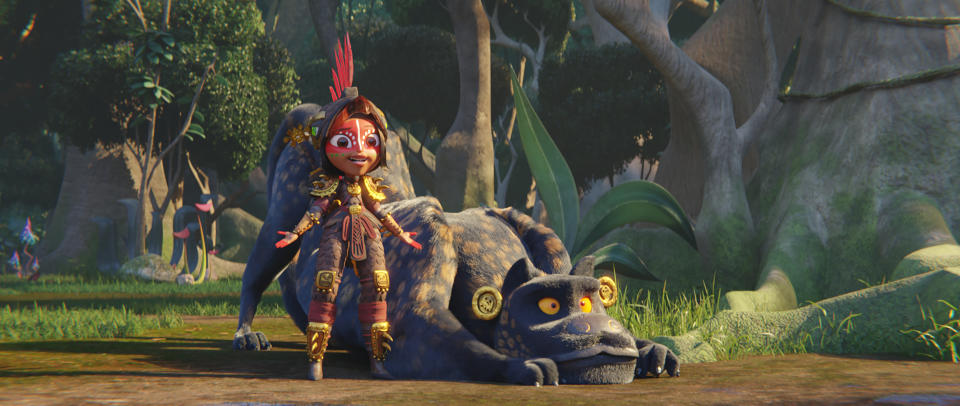‘Maya and the Three’: How Netflix’s Animated Limited Series Embraced the ‘Jorgeverse’

- Oops!Something went wrong.Please try again later.
- Oops!Something went wrong.Please try again later.
Jorge Gutiérrez’s long-awaited animated Netflix limited series, “Maya and the Three,” about a rebellious Mesoamerican teenage princess battling the gods of the underworld, celebrates the culture on an epic scale. Told in nine parts, it boasts a dazzling array of visual styles evoking hand-drawn 2D, stop-motion, and CG animation.
Indeed, “Maya and the Three” is proof that the Mexican animation auteur (“The Book of Life,” “El Tigre”) is at the top of his game. Then again, Gutiérrez is just getting started with what his wife and longtime collaborator Sandra Equihua calls the “Jorgeverse.”
More from IndieWire
'Tiger King 2' Trailer: The Joe Exotic Saga Continues, From a Cage of His Own
'Squid Game' Creator Roasts LeBron James After Finale Criticism: Have You Seen 'Space Jam 2'?
“We’ve been in the industry for 21 years just trying to make stuff,” Gutiérrez said. “I finally feel like we’re being trusted to make [what we want] in a way that reflects who we are. […] We’re the same people from 20 years ago. It’s not like we’re different in any way. It’s just that now we’re given more opportunities.”

Fresh from CalArts, the duo landed on the scene in 2007 with Nickelodeon’s multi-Emmy Award-winning series “El Tigre,” an homage to Mexican Luchador culture wrapped in a family sitcom. Gutiérrez’s vibrant 2014 Golden Globe-nominated feature, “The Book of Life,” took a spectacular dive into Día de los Muertos, receiving an Annie Award for character design.
However, “Maya and the Three” finally offered Gutiérrez the chance to experiment with animation in ways that he wasn’t allowed previously. This included playing with framing and aspect ratio in order to underscore big moments: a technique he had wanted to employ on “The Book of Life.” Extending the frame had become another tool in Gutiérrez’s arsenal, “just like we use music and sound and color to give the audience a little something extra, we use that too,” he added. “And I can never go back. Now I want to do this all the time.”
Equihua and Gutiérrez divvied up the myriad character designs, including an entire pantheon of gods, for “Maya and the Three,” with Equihua taking on the children and female characters. “It’s been trial and error with Jorge ever since we started working together,” she said. “Through a series of steps, we figured out that we should work with each other’s strengths. And my strength is females, cute kids… and Jorge is more about the men, the monsters, big, gnarly-looking creatures.”

Netflix
The pair has integrated “all the back-and-forth,” Equihua said. “My philosophy on design is less is more, whereas Jorge’s is more is better — as you can clearly see from the series — but that juxtaposition really helps each other’s characters in development.”
“Maya and the Three” villain Lord Mictlan (Alfred Molina) is a perfect example of Gutiérrez’s excess. “Secretly, when I saw him,” Equihua said, “I was like, ‘I don’t know how that thing is going to move,’ but he had faith in it from the start and we had a really good team helping us out. And, through the power of Grayskull, we figured it out, and it’s flawless.”
This is “a golden time” for people working in animation, according to Gutiérrez, who credits Netflix with giving creators a global platform for telling their stories. “What Netflix has done with people like us is that they’re saying, ‘You can now make something authentic from your culture, and it’s for the whole world. And we will support that vision.’ Earlier in our career, it was always, ‘Whatever you guys make has to work for the U.S. And if it works outside of the U.S. — bonus.’”
“Maya and the Three” reprises many of the talents from “The Book of Life,” including Zoe Saldaña as the spirited Princess Maya and Diego Luna as Zatz, the handsome and magnetic Prince of Bats who’s sent to bring Maya back to the underworld on her 15th birthday. The sprawling voice cast also includes a host of A-listers such as Gael García Bernal, Wyclef Jean, Queen Latifah, Cheech Marin, and the legendary Rita Moreno (“West Side Story”), as well as Gutiérrez and Equihua as Maya’s parents, the King and Queen of Teca.

Netflix
Gutiérrez also reunited with “The Book of Life” production designer Paul Sullivan and Oscar-winning composer Gustavo Santaolalla (“Babel,” “Brokeback Mountain”) for “Maya and the Three.” Working with artists from around the globe, the animation for the series was completed at the since-shuttered Tangent Animation Studios in Toronto and Winnipeg. The production team opted to use open-source software Blender to bring the project to life.
“I’m a CG techie guy,” said Gutiérrez, who had fallen in love with Tangent’s earlier work on the animated feature “Next Gen.” “I could not believe they did that with Blender,” he said. “The team over there was brilliant. And, sure enough, when they started testing for ‘Maya,’ I saw stuff that changed completely the way I approached things.”
The remote-distributed workflow enabled by Blender proved to be especially useful during the pandemic lockdown. “When Covid hit, they were more than ready to work remotely and work from home,” Gutiérrez said. “My hat’s off forever and ever to the now-defunct Tangent Animation for creating this brilliant, brilliant piece of animation.”
“Maya and the Three” is available to stream on Netflix.
Best of IndieWire
'Cowboy Bebop': Everything You Need to Know About the Live-Action Netflix Adaptation
'The Last of Us': Everything You Need to Know About HBO's Adaptation
Sign up for Indiewire's Newsletter. For the latest news, follow us on Facebook, Twitter, and Instagram.


